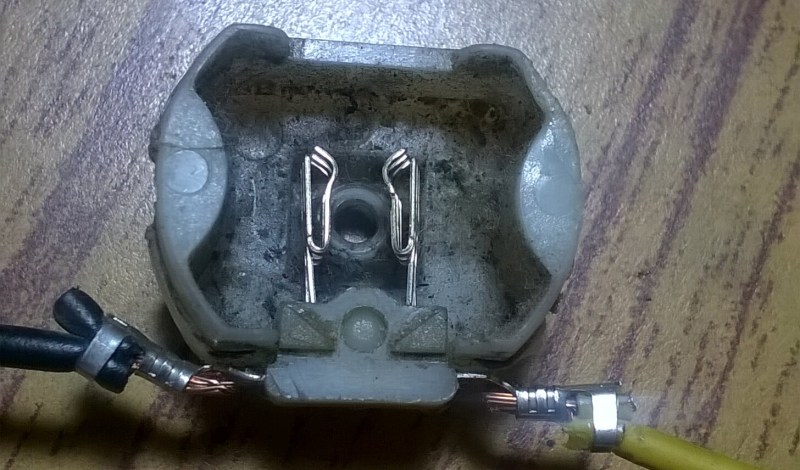[dmalhar] was digging around in his bins for motors and found one with missing brushes. Being resourceful (and not able to find another motor), he managed to tear apart a SATA cable and form the pins into brushes with just the right amount of spring. Yes, this looks like a cheap motor, but in the moment of necessity availability wins, and this hack is truly commendable. If he had used a paperclip, MacGyver would have been proud, but the SATA cable pins make us proud.
Normally the brushes of DC motors are made with a graphite or some other material which provides a small amount of resistance so that when the motor is spinning the brushes will provide a gradual shift of current from one commutator to the next. Also, the softness of the carbon makes the brush wear down instead of the commutator, and in large motors the brushes are replaceable. In cheap motors the engineers design the brush material around the expected lifetime of the product. In [dmalhar’s] case, the motor just got its lifetime extended by a while.
















but in the moment of necessity[,] availability wins
Missing a comma.
“Missing a comma.” is a sentence fragment.
Intentional fragments are not grammatical errors. In addition, I am not paid anything to create or proofread posts.
This isn’t a literature site. You should expect grammatical errors, poor spelling, and the occasional copy and paste mistake. Personally, I’m far more concerned about the information than the presentation.
This reminds me the good old days where I started playing with electronics when I am in class 5. That time I got a similar motor with the brush got damaged. I used the copper spring plate from on old tape recorder cartridge which supports the tape from bottom where the record/playback head get pressed.
I used some copper wire from the BSNL telephone lines when I was 5.
Hey man! You remind me about essay subjects in 5th grade by the title of your website/blog. however, great work there.
(I didn’t find a comment box on your website,sorry.)
Brilliant hack! Very well done.
I don’t know how long it will last, but perhaps it will last long enough for the motor to be replaced.
I recently bought a 10A Variac at a hamfest that was missing the brush. Since a new brush would cost $60USD or more, and I only paid $15 for the whole thing, I decided to make my own. I soldered several #12AWG copper wires together in parallel and then filed them down to the correct shape. Much to my surprise, the thing works! (though it does spark a little bit) Wear isn’t really an issue as I only use the thing once in a while.
Thank you.
You’re quite welcome. That’s some clever wire bending work there. :)
A Variac is an auto-transformer so you need to be careful that the wiper doesn’t create a shorted loop in the coil.
http://sound.westhost.com/articles/variac.htm
Thanks for the link. I was very careful in shaping the brush, and it should be narrow enough to avoid shorting turns.
Would it be possible to make a carbon brush out of some cheap motor brush? Sometimes it is even a carbon/graphite wheel to reduce wear.
One of the know issues with SATA cables is that they are designed for very few insertions, so that makes me wonder how long a hack like this will last.
Although the eSATA cables are more robust I think, so maybe if it was one of those it would work better.
Or how about a HDMI connector?
The motor will be dead before the brushes,maybe.
Don’t count on that. SATA cables are among the worst piece of junk ever designed by a human, their guaranteed life is tens of insertions-removes. Yes, neither thousands nor hundreds but tens. Won’t last long, but clever hack anyway.
I used what I had on that moment. If I had other things like paperclips, I may have used those. I found this motor and a bundle of wires from an old PSU at 1 am, so I used those.By the way, you can find it out at
whatdidihack.wordpress.com
( looks and theames are pending, I am on move,I’ll update those when I get home.) .
Thank you Hackaday and [Bob Baddeley] for this amazing write-up.
I can never write like this. My native language is not English,Sorry.
I think you wrote your article quite well. It was easy for me to understand what you were doing and I feel the excitement at pulling of a zero-cost and on-the-spot repair. Nice!
I once used a springy section of a (tin?) can. It quickly carbonized(?) and current would not pass any more. So sanding often was necessary.
My father had a radio sent to Anchorage for repair from the north slope. a transistor failed after repairs done up north, the mica insulator had been replace by a perfectly cut and shaped piece of ivory in a previous repair. Over time the ivory had gotten hot enough to char and began to arc but it had lasted for three years!
Must have been narwhal ivory then eh